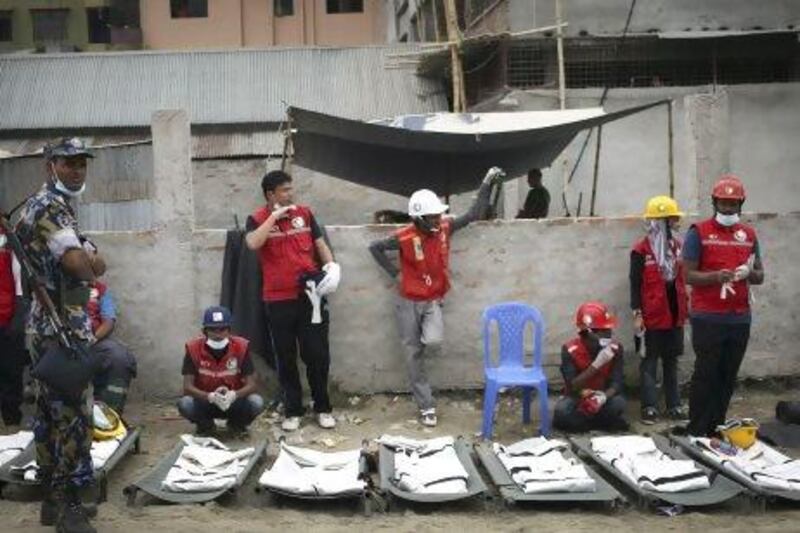SAVAR, Bangladesh // Police will have 15 days to interrogate the owner of a building that collapsed last week and killed at least 382 people, a Bangladesh court said.
Mohammed Sohel Rana, who was arrested on Sunday near the border with India, will be held for questioning on charges of negligence, illegal construction and forcing workers to join work. His father, Abdul Khaleque, was also arrested on suspicion of aiding Mr Rana to force people to work in a dangerous building.
The illegally constructed, eight-storey Rana Plaza collapsed in a heap on Wednesday along with thousands of workers in the five garment factories in the building. About 2,500 survivors have been accounted for. Rescuers started using heavy machinery yesterday to cut through the destroyed structure after giving up hopes of finding any more survivors.
Mr Rana was brought to court in a bulletproof vest, and led away to an unknown detention facility after the magistrate granted a police request to hold him longer before filing formal charges. The crimes he is accused of carry a maximum punishment of seven years. More charges could be added later.
The collapse was the deadliest disaster to hit Bangladesh's garment industry, which is worth Dh73.4 billion annually and supplies global retailers.
In renewed anger against conditions in garment factories hundreds of workers poured into the streets in the Dhaka suburb of Ashulia and set fire to an ambulance yesterday, Independent TV, a private network, reported. They also tried to set fire to a factory. Authorities shut down all garment factories in Ashulia and Gazipur industrial suburbs, including one that had reportedly developed cracks and was evacuated earlier.
Volunteers, army personnel and firemen have worked around the clock since Wednesday, mostly using hands and light equipment to pull out survivors. Around midnight on Sunday, authorities deployed hydraulic cranes and heavy cutting machines to break up the massive slabs of concrete into manageable segments that could be lifted away.
"We are proceeding cautiously. If there is still a soul alive, we will try to rescue that person," said the army spokesman Shahinul Islam.
"There is little hope of finding anyone alive. Our men went inside and saw some dead bodies in the ground floor. But no one was seen alive," said Brigadier General Ali Ahmed Khan, the chief of the fire brigade at the scene.
Gone are the civilian volunteers who had swarmed the site since the disaster and crawling over the wreckage. Only army soldiers in green camouflage and hard hats were visible, watching heavy machinery digging into thick concrete. Gone also were the waiting ambulances that over the past five days had rushed the rescued to hospitals.
The prime minister, Sheikh Hasina, visited the site and a nearby hospital to meet survivors, the first time since the disaster.
Ms Hasina had ordered the arrest of Mr Rana, who is a small-time political operative from her Awami League party's youth wing.
He had permission to build a five-storey building but added three more illegally. He last appeared in public on Tuesday in front of the Rana Plaza after huge cracks appeared in the building.
Witnesses said Mr Rana assured tenants that the building was safe. Police, however, ordered an evacuation. A bank and some first-floor shops closed, but managers of the garment factories on the upper floors told workers to continue their shifts.
Hours later, the Rana Plaza was reduced to rubble, crushing most victims under massive blocks of concrete.
Police have also arrested four owners of three factories. Also in detention for questioning are two municipal engineers who were involved in approving the building's design. There were reports that the bank accounts of the owners of all five garment factories had been frozen.
A garment manufacturers' group said the factories in the building employed 3,122 workers, but it was not clear how many were inside when it fell. About 2,500 survivors have been accounted for.
Among the garment makers in the building were Phantom Apparels, Phantom Tac, Ether Tex, New Wave Style and New Wave Bottoms. Altogether, they produced several million shirts, trousers and other garments a year.
The New Wave companies, according to their website, make clothing for several major North American and European retailers.





